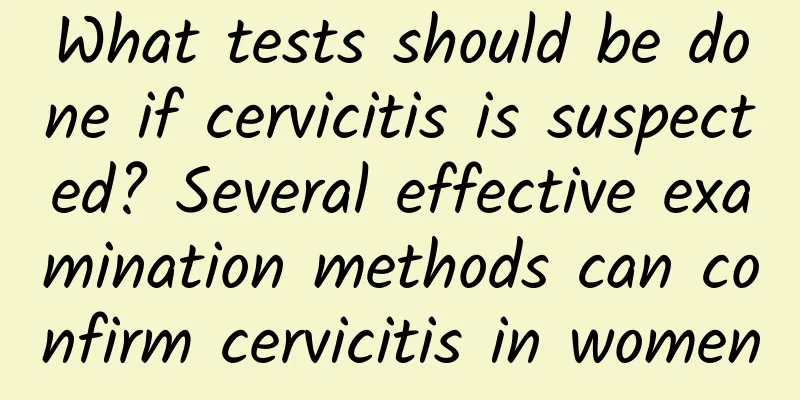What tests should be done if cervicitis is suspected? Several effective examination methods can confirm cervicitis in women

|
Cervicitis is a common gynecological disease. Common symptoms include increased leucorrhea with possible blood streaks, vaginal bleeding with odor, and a feeling of heaviness in the abdomen. If you experience any of these symptoms, experts recommend that you go to the hospital for a checkup on cervicitis. Regarding the examination of cervicitis, colposcopy is the most basic, simple, easy, cost-effective, and the most important auxiliary examination and the most effective initial screening method for cancer prevention surveys. Colposcopy method: Avoid vaginal douching, examination and sexual intercourse within 24 hours before the examination; place a vaginal speculum and gently wipe the cervical secretions with a cotton ball; turn on the power and adjust the distance until the image is clear. The magnification can start from 10 times and increase from there; apply 2% acetic acid to the affected area to purify and swell the local tissue, which is conducive to observation. Remember to record and describe what you see after observation; when observing blood vessels, you need to add a green filter lens to the objective lens and magnify it 20 times; if suspicious lesions are found under the microscope, take local living tissue for pathological examination. After the examination, remember to turn off the power and reset it. Colposcopy precautions: 1. When inserting the vaginal speculum, be sure to remember that lubricants cannot be used. The vaginal speculum should be inserted while dilating under direct vision to avoid scratching the cervix. 2. Patients with suspicious lesions should undergo biopsy under colposcopy. 3. Fully expose the cervical canal to avoid misdiagnosis and pay attention to those with inward migration of the transformation zone. 4. Regarding the selection of examination time, there is no time limit for suspected cervical cancer or cervical intraepithelial neoplasia. It is advisable to examine the lesions in the endocervical canal close to the ovulation period or the ovulation period. For other diseases, it is advisable to examine within 2 weeks after the end of menstruation. 5. Colposcopy cannot confirm the pathological tissue examination. 6. The combined use of colposcopy and cytology can reduce the missed diagnosis rate. Finally, when the results of colposcopy are abnormal, other tests can be combined for further diagnosis to avoid misdiagnosis or missed diagnosis. 1. Iodine test and naked eye observation method: This method is very simple and cheap, and can detect at least 2/3 of the lesions. As a preliminary screening method for cervical cancer, 3%-5% acetic acid solution is applied to the cervix. The reaction of the cervical epithelium to acetic acid is observed, and then a biopsy is taken from the white lesion area. 2. Cervical smear cytology examination: Cervical smear cytology examination is the most basic examination for cervicitis. It is simple, easy, and cost-effective. 3. Gynecological examination: Focus on checking the size, shape, texture, thickness of the cervical canal, and whether there is contact bleeding. Secondly, check the condition of the vulva, vagina, uterus, and paracervical tissues. |
>>: What are the symptoms of female cervical erosion?
Recommend
What are the complications of vaginitis?
In life, vaginitis has been affecting the normal ...
What if my period is brown for 8 to 10 days?
What's wrong with the brown color of my perio...
How to differentiate dystocia?
How to diagnose and identify dystocia? If dystoci...
Experts explain the causes of moderate cervical erosion
Moderate cervical erosion is a common type of cer...
Understand the 4 harms of vulvar leukoplakia to patients
Vulvar leukoplakia is the degeneration of vulvar ...
How to treat mild cervical erosion
How to treat mild cervical erosion? The general t...
Can female cervical erosion be cured by medicine? Is simple drug treatment effective for female cervical erosion?
In life, whether married or unmarried women, the ...
What foods can eliminate uterine fibroids? What foods can eliminate liver cysts?
What foods will get rid of uterine fibroids? What...
How long after abortion can you get pregnant again
It is usually recommended to wait at least 6 mont...
What should you pay attention to in your diet when you have endometriosis?
The dietary rules for endometriosis are something...
Will uterine fibroid surgery affect fertility? Common treatments for uterine fibroids
Many patients with uterine fibroids may worry abo...
Don’t be NG with the crazy facial mask! 4 major pitfalls of applying facial masks
It is well known that Taiwanese women love to app...
Can I get pregnant with long-term irregular menstruation?
Although women with long-term irregular menstruat...
How much does it cost to get a leg slimming injection?
How much does it cost to get a leg-slimming injec...
To avoid regaining weight and the pain of losing weight, you should know the solution
Being overweight or obese has become a global pub...









